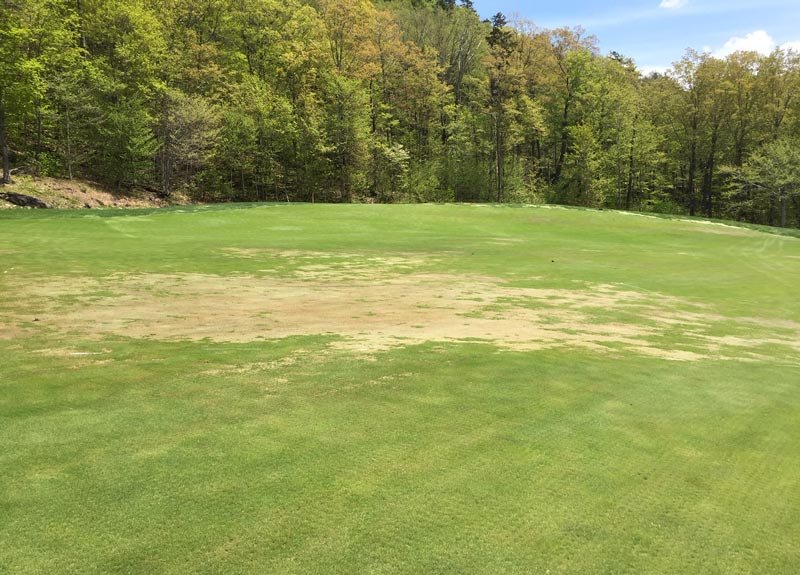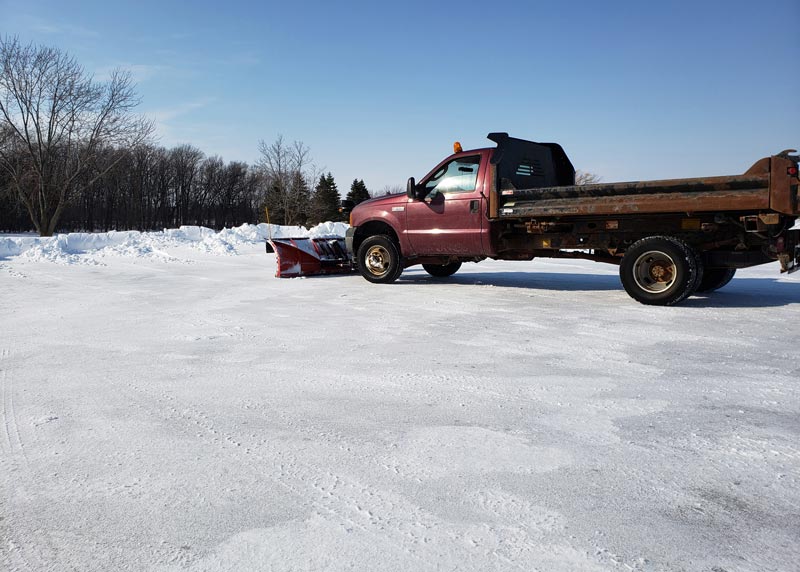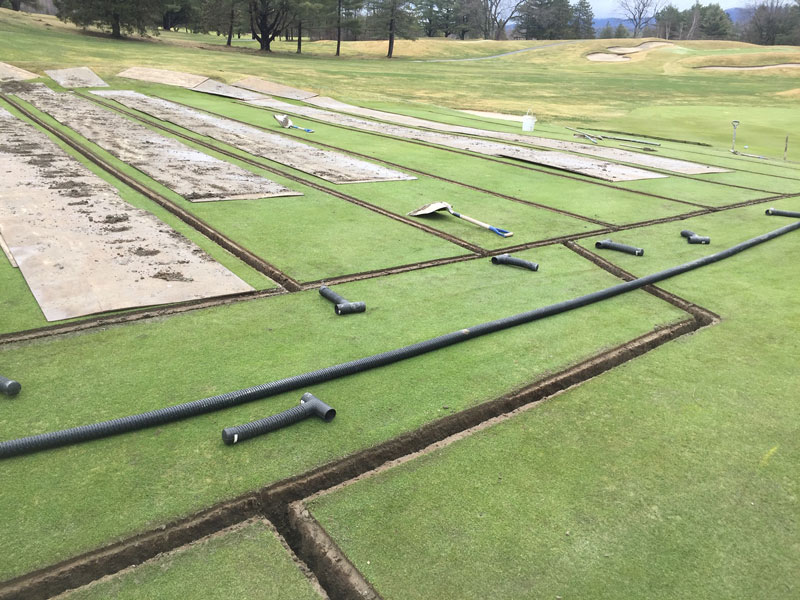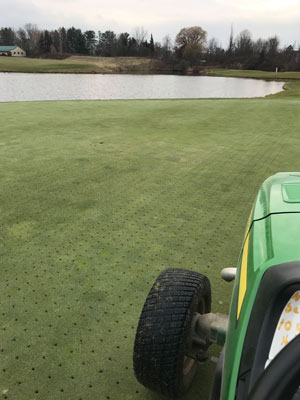
A patch of winterkill at Stowe (Vt.) Country Club, the result of a low spot on a fairway. Photo by Kevin Komer
Snow is good. Ice is bad. Beware starving owls, woolly caterpillars, stinky sub-ice air and depressing long-range forecasts from Farmers’ Almanac.
The reasons? Starving owls mean the ice is thick on your greens. Wooly caterpillars tell you winter’s going to be long and cold. A bad smell underneath ice screeches anaerobic respiration. And the Farmers’ Almanac is more often correct than wrong in its long-term forecasts.
Thus ends lesson one of “Golf course maintenance 101: Winter-to-spring survival.” Because “survival” is exactly what it is.
Lesson two? For sanity’s sake, golf course superintendents across the northern zone should remember the words of the late, legendary Stan Zontek, USGA Green Section Mid-Atlantic director, who once said, “It’s such a crapshoot. One year, your club considers you a genius; the next, you’re the village idiot.”
Battle-worn superintendents with experience dealing with the North’s harsh winters agree on one thing: Mother Nature is sometimes Dr. Jekyll, and other times Mr. Hyde. Don’t expect her sympathy — just enjoy her compassion when you get it.
“Mother Nature rules the day,” says Kevin Komer, CGCS, director of agronomy at The Mountain Course at Spruce Peak and Stowe Country Club, both in Stowe, Vt. “That’s our job — dealing with her. Up here, it’s not a matter of if you’re going to lose grass, but when.”
“It’s true,” says Josh Yerdon, the GCSAA Class A superintendent at Fairways of Half Moon in Mechanicville, N.Y. “Sometimes there’s no rhyme or reason why guys get damage one year and not the next in one area, and in another one another year.”
“There’s a lot of luck involved. That’s for sure,” agrees David Brandenburg, CGCS, who oversees Rolling Meadows Golf Course in Fond du Lac, Wis.
And golfers at Green Meadow Golf Club would be quick to agree that fortune seems to shine brightly on superintendent Andrew McHugh, whose 36 holes in Hudson, N.H., are known to be the last to close for winter and the first to open in spring.
Here, drawing on their more than 125 years of combined knowledge, these five superintendents from the rolling meadows to the foothills and mountains of America’s North Country share from the “toolboxes” they use to prepare their courses for winter and then launch the turf into playability come springtime.
As Ed Michaud, the superintendent and part-owner of Fox Ridge Golf Club in Auburn, Maine, says of the challenge: “We have three seasons in Maine: winter, recovering from winter and preparing for winter.”
Winter golf course maintenance: The preparation
There are standard operating procedures taught in every turfgrass textbook at every turf school in the country as they relate to preparing for and recovering from winter’s worst. Then there are the tricks that not everyone knows about.
First, the SOPs:
- Blow out the irrigation system.
- Leave the grass a bit longer when you stop mowing.
- Load up the carbohydrates to protect against crown hydration.
- Lay down fungicides.
- Spread a heavy layer of topdressing or several light layers.
- Take care of the mechanical side of the operation from equipment to ball washers (see “Winter work rolls on for northern supers,” below).
- Be aware of clues that point to problems you might not realize, like the starving owl mentioned above.
“Around the end of last February, the TV news said people in the area had owls sitting on their porches and staring in the windows,” recalls Michaud, a 31-year GCSAA member. “The biologists said that because of the ice layer, all the owls’ food, the mice and squirrels, were unavailable. The owls couldn’t get through the ice to get to their prey, so they were starving.”
Michaud’s antenna went up.
“I knew I had ice, but didn’t know it was 6 to 8 inches thick,” he says. “Even the banks around the greens had ice on them. I’d never seen that before. I could have almost ice-skated around the whole golf course.”
Because regular snowblowers can’t throw the snow far enough, Michaud hitched a 6-foot snowblower onto the back of a tractor and cleared off the greens to lay down sunflower seeds to hasten ice melt.
“If you get a 60-degree day and the sun’s high ... you run around and spend five to 10 minutes a green sweeping the sunflower seeds off the turf onto what ice you have left,” he says.
In the future, Michaud says he will rent a big skid steer with a snowblower on the front instead of a bucket and rubber tracks, “so if you break through the ice, you won’t damage the green too much.”
“A lot of winterkill happens in late March and early April when the freeze-thaw cycle is going,” adds Komer, a 28-year GCSAA member. “In late spring, we’re moving water off to stop that thaw. That’s the nervous time for me.”
Agronomic realities make the SOP program crucial, but timing is critical — and, in some cases, problematic.
“We check not only the one-day forecast, but the five- and 10-day forecast,” says Brandenburg, a 31-year member of GCSAA whose course, as its name implies, is tucked among rolling meadows. “It takes time to prepare for winter. You don’t want to do it too early, but you also don’t want to miss your window. And that window varies by the year. You hope for a week, but sometimes it’s just a matter of days.”
That process starts with two days to blow out the irrigation system. “This year, a lot of golf courses in Wisconsin got caught by early snows and were blowing out their systems with 2 or 3 inches of snow on the ground,” Brandenburg says. “It was a challenge.”

In March 2019, David Brandenburg, CGCS, had to break out the plow to clear ice from a green at Rolling Meadows Golf Course in Fond du Lac, Wis. Photo by David Brandenburg
Adding carbohydrates is the next important step in preparations. Sometime in late October to early November, Yerdon, whose course 15 miles north of Albany, N.Y., is hilly, uses growth regulators on a two-week schedule right up until the first frost. “I’d rather the plant is using its energy working on the bottom roots rather than top growth,” says the 19-year GCSAA member.
Meanwhile, Michaud feeds his fairways from 1⁄2 to 3⁄4 pound of nitrogen and a pound of potassium, and lays down 0-0-50 on his greens, “though this year I did them twice because the fall was so warm,” he says.
“What happens is the turf plant uses up its carbohydrate storage,” Michaud explains. “Especially in the spring, the plant is getting weak and starting to starve to death. The protoplasm inside the cell walls gets less and less saline, so it becomes more and more susceptible to freezing. When that protoplasm inside the cell freezes, it expands and bursts a hole through the cell wall, and now it’s dead. That potassium, basically salt, helps keep that protoplasm from being so susceptible to freezing. It helps with carbohydrate storage and buildup.”
Fungicides in the prep process generally address the threat of snow mold. “It can be a big problem, but it’s also easy to solve,” Yerdon says. “I use a combination product with several different active ingredients on putting surfaces, and a fungicide with fewer active ingredients on fairways.”
McHugh, who offered the hint on breaking through ice to smell for anaerobic respiration, adds, “If so, we’ll get the snow off and put down some more Milorganite, or green or black sand to help melt through the ice — something with a dark color.”
McHugh also sprays Sili-Kal B, a high-calcium product with nitrogen, potassium and silica, along with his fungicides.
In most instances, topdressing is the final piece of the prep puzzle. Brandenburg explains his topdressing tactic this: “We put down a heavy layer (1⁄8 inch) of sand on the greens to protect the crowns from desiccation. If we have an open, dry winter, it gives them some protection. When we put it down, you can’t see the turf, but by spring, the grass has grown through.”
Michaud adds that the timing of the topdressing is critical. “You want to topdress heavy enough to protect the ground and have some protection if you need to plow them off,” he says. “It’s insurance in case you have to go out and plow. If you break through to the grass, you might get some damage, but it’s superficial because the crown’s protected by that sand layer.”
Some superintendents add Milorganite to their topdressing program.
The critical truth remains — snow is good, and ice is bad.
Northern superintendents’ unique toolkit
Being inventive and fixated on anything that helps improve their maintenance regime, superintendents’ hints on mitigating winter damage range from drain covers to spray covers, deep-tine aerification to verticutting, fixing spot damage to draining entire greens.
Komer, whose Robert Cupp-designed Mountain Course at Spruce Peak is only 12 years old and sports Penn A-4 and L-93 creeping bentgrass, says Existing Greens Drainage (XGD) can be a godsend for golf courses with older pushup greens like his at Stowe Country Club, which suffered from “chronic winterkill” because of standing water.
While “modern drainage” — aka USGA sand-based greens construction — is an immense help, XGD can do the same, Komer says. “If you have older greens that don’t move water well and you have winter drainage, this XGD really helps.”

Kevin Komer, CGCS, swears by the benefits of Existing Greens Drainage (XGD) to help prevent winterkill on pushup greens like those at Stowe (Vt.) Country Club. Photo by Kevin Komer
Using a small trencher, a company came to Stowe, pulled out the old, thick soil, dropped in 2-inch drainage pipe, covered the pipe with sand, and then added sod. Problem solved.
With standing water being a major concern, especially during January thaws, Komer also uses what he calls “collar cuts” to move water off greens.
“Technically, they say bentgrass can survive 90 days under ice, but I’ve seen a lot of bentgrass die from ice damage,” Komer says. “Wherever water may get held up in our collars — what I call ‘collar dams’ — we cut sod-cutter-width slits in the collars to help the water flow.”
In November, before there was a lot of snow, Komer’s crew also went out on a wet day and squeegeed the greens just to get that water off.
When it comes to green covers, considerations of microclimates and timing take center stage.
Komer uses permeable covers during winter on seven greens that get no snow cover but are impacted by wind. Michaud only uses the permeable type in spring to hold in the heat during the cool nights.
“You’re never 100% dead,” Michaud says. “If you have covers on, every two or three days you have to pull them off, mow the green where the grass is still alive. It’s a total pain, but it made all the difference in the world last year with a cold spring. We dealt with temporary greens for a couple weeks in April or early May, but you have your greens for most of the season.”
Other superintendents stay clear of permeable covers altogether because timing of their use is critical and can be confounding, and because the course can’t open for play with covers on.
Meanwhile, the newest entry into greens protection are products that are sprayed on. Precision Laboratories’ Wintergreen and Lesco’s Green Turf Paint contain permanent green pigments so they warm up the soil in spring and help restore natural green color to dormant turf.
McHugh uses the Lesco Green, and Komer the Wintergreen, which Komer further describes as an anti-desiccant and a darkening agent to help warm the soil surface in spring.
And although he doesn’t use Ice Shield covers from Evergreen Turf Covers, Yerdon says he has heard rave reviews about them. “I’ve talked to guys who use Ice Shield covers because they don’t want anything touching the turf during the winter,” he says. “Once the plant stops growing, they put down the Ice Shield, and they say they’re having great luck with them.”
And then there are drain covers and their importance to getting water off the course. “Our drain covers have a tight grate, so we take them off so that slush and snow can drain down rather than clog up the drain covers,” Brandenburg says.
Beyond the surface
Yerdon adds two more twists to his course preparation — wetting agents and deep-tine aerification. “Right before ground freezes, we use the best penetrant wetting agent I can find to help move the water off the turf so you won’t have to deal with so much ice,” he says. “That goes with deep-tine aerification with 3⁄4-inch solid tines, and leave them open right through the winter to help move any water down, off the surface away from the crown of the plant. If we’re still clear in mid-November, I’ll do it again in mid-December if we’re not frozen.”
Komer takes a practical view of preparation and recovering. “The key to success up here in the higher elevations is how you recover from damage,” he says. “You’re bound to get it some at some point. So you have a good plan for how to grow back damaged areas.”
How?
“Do what you can, and you do all of it,” he says. “Usually in mid- to late April up here — because it’s so cold that if you do it any sooner, the seed will just sit there — we usually verticut and drop bentgrass seed in, brush it and sand it, and sometimes cover it to help germination. In the fairways, a lot of times we’ll take green covers off the greens and use them.”

Right: The crew at Fairways of Half Moon in Mechanicville, N.Y., uses late-season deep-tine aerification with 3⁄4-inch solid tines to aid the movement of water from the putting surface. Photo by Josh Yerdon
Often in the North, only portions of greens get damaged, but because of the demands to open for play, superintendents are left treating just those damaged spots.
“You still want to grow that small area in and continue to mow and do other things you have to do on the healthy grass for golfers,” Komer says. “All of a sudden you have a good catch of seed and you don’t mow it properly and the mower drives through it and crushes the seed, or the golfers walk over it. ... It’s a difficult thing to do in the spring.”
The solution is to constantly throw down seed.
“So after you verticut it and get that initial seed down, every few weeks you poke more holes and put more seed down,” Komer adds. “The amount of time we spend on these little spots on greens is crazy.”
McHugh, who points to moisture sensors as one of the most important tools in dealing with keeping turf “a little drier going into the fall,” points to the turbine blower as helpful in readying the golf course for golfers coming out of winter.
“Most golfers are perfectly happy to get out there early if you only clean up the greens from debris, leaves and sticks,” he says. “A lot of that is weather-dependent, but the turbine blower makes a big difference. As opposed to tractor-mounted blowers, the turbine blower is lighter and smaller and allows you to clean the greens off much earlier.”
A sod supply of one’s own
An underreported happening in 2019 was serious news for some superintendents: the lack of creeping bentgrass in New England.
Sod farms in the region have largely stopped growing creeping bentgrass, making it all the more important for superintendents to grow their own turf.
Last spring, the Northeast suffered a lot of winterkill, and at one point, New England ran out of creeping bentgrass sod, according to Komer.
“I had 3 acres of damaged fairways,” he says. “We sodded half of that. But at one point in late spring, I couldn’t get any local bentgrass sod at all. And the cost to transport it from afar is prohibitive.”
Komer has a 6,000-square-foot bentgrass nursery and suggests other Northeastern superintendents do the same.
Open for business
Two bottom lines exist for superintendents the world over: keeping their courses healthy and their golfers happy.
McHugh, after 25 years at daily-fee Green Meadow, says, “If it’s a bright, sunny day, golfers always call and ask, ‘Are you opening up?’”
Yerdon, in his 11th year at the public Fairways of Half Moon, says, “We basically have play as long as we can. Our latest was Christmas Eve. We had 90 golfers four or five years ago on a beautiful, 65-degree day.”
Brandenburg, who has been at Rolling Meadows for 21 years, can do Yerdon two better. “This year (2019), we gave the customers a gift,” he says. “The course was firm enough that we were open the day after Christmas. We had 101 players, one of them in shorts. The day started at 50 degrees, and by dark, it was 32.”
And there were no complaints.
Winter work rolls on for northern supers
Flipping the switch from winter to spring means no rest for the weary at golf courses across the northern states.
When weather allows, crews are out on the course. When not, they’re working on projects indoors, either in the shop or the clubhouse.
Even before snow hits, Ed Michaud at Fox Ridge Golf Course in Auburn, Maine, is preparing for one job most superintendents outside the region don’t even consider: snowplowing.
“We have to stake off the driveway,” he says. “I put 5-foot stakes 8 to 10 inches into the ground so I know when I’m plowing the driveway. When the wind blows hard out of the northwest, the next morning you can’t even tell where the road is. Without the stakes, I’d be guessing.”
Meanwhile, in midwinter, Michaud brings his snowmobile to the course to get around and do tree work if there’s a particular job he thinks needs to get done by spring.
In mid-January, David Brandenburg, CGCS, from Rolling Meadows Golf Course in Fond du Lac, Wis., reported, “The past four days we’ve been out with a brush cutter, taking back tree lines where scrub brush has grown. We’ll do quite a few of our tree lines next week.”
Otherwise, mechanics and superintendents use the time to give all of their equipment a tuneup and do steam cleaning and painting.
“We check all the belts and hoses and make sure there isn’t any freeze or anything that could cause a possible leak coming into the season,” Brandenburg says. “The main thing is to make sure all the reels and bedknives will give us a good-quality cut come spring.”
“We try to have all the grinding and sharpening done before the new year so we can spend January, February and March doing all our preventive maintenance,” Michaud says. “It’s almost a two-month job, grinding, rebuilding wheels and rollers.”
Editor’s note: Knock out these oft-deferred equipment service tasks during the slower days of winter to ensure smooth operations once the golf season is in full swing.
“We paint and steam-clean all our stuff, paint tee markers and make new ones if need be. We always have spare tee markers in four colors,” Michaud adds.
“We keep busy one way or another,” Brandenburg says. “We make sure ball washers and brushes are good and replaced if needed. Everything is given a fresh coat of paint. We check our water coolers in case they need new spigots. And normally, we have some kind of project in the clubhouse. This winter, we’re replacing the flooring in the bar.”
Perhaps turf school programs might want to consider offering carpentry courses?
Mark Leslie is a freelance writer based in Monmouth, Maine, and a frequent contributor to GCM.